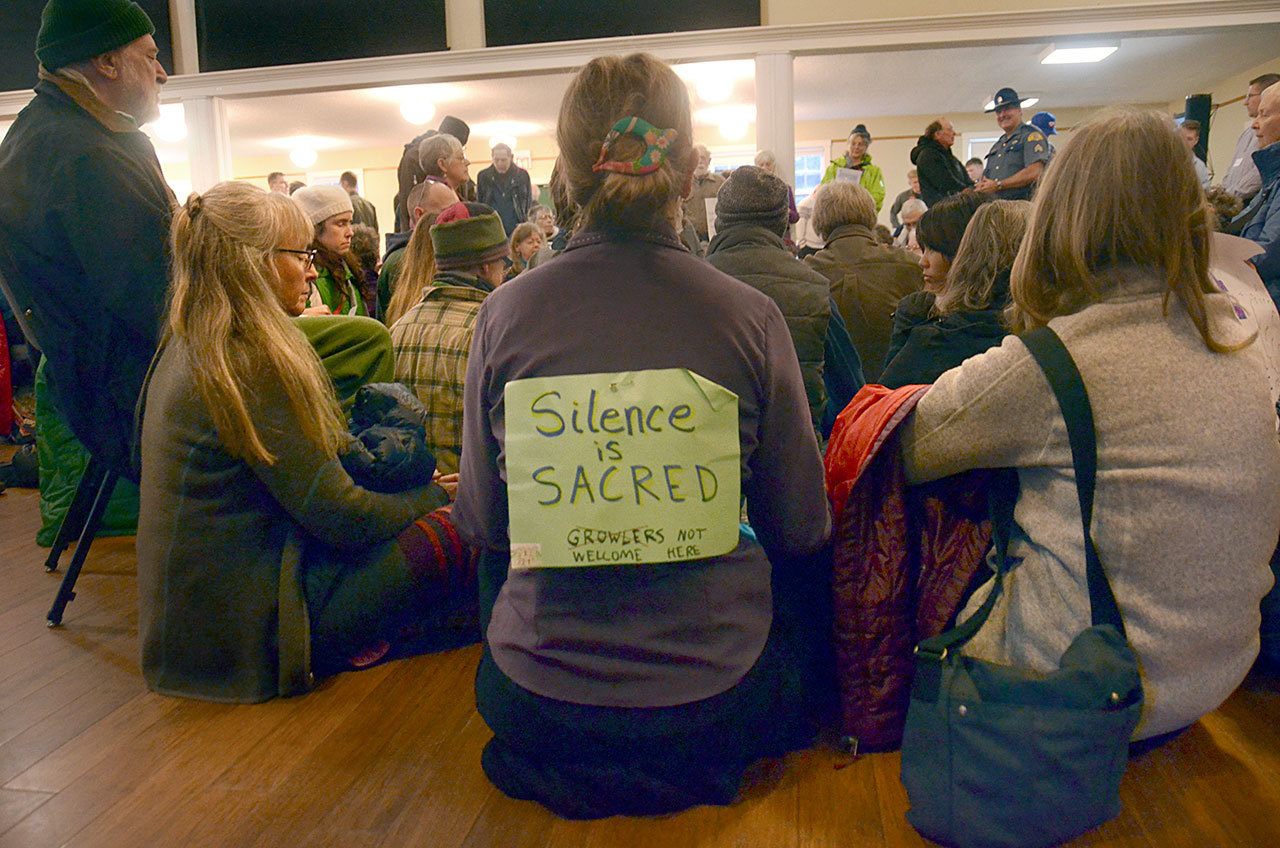PORT TOWNSEND — Whichever alternative the Navy chooses for adding EA-18G Growler jets and training flights to Naval Air Station Whidbey Island, Port Townsend residents will hear jets more often, Navy officials said.
Navy officials on Monday afternoon conducted an open house at Fort Worden on its draft environmental impact study (EIS) on adding 35 or 36 Growlers to the Whidbey Island air station and increasing training flights. The plan would increase the number of personnel and training flights taking place on Whidbey Island starting as soon as 2017.
A few hundred people attended, many concerned about the increased noise on the North Olympic Peninsula.
“This is one of the most peaceful places on Earth,” said Mary Foster of Port Townsend. “Why are we making all this noise? People live here because they enjoy the quiet.”
Three alternatives
The draft EIS considers three alternatives, each with three scenarios, for a total of nine possible plans. The biggest factors studied are the number of personnel and training flights working out of the Navy’s two airfields on Whidbey Island: Ault Field and Outlying Landing Field (OLF) Coupeville.
The statement was released Nov. 10, beginning an extended 75-day public comment period that ends Jan. 25, when all comments must be postmarked or received online. The draft EIS is available for review at www.whidbeyeis.com.
Port Townsend is most affected by flights coming out of OLF Coupeville due to its proximity to town and the flight paths of planes going in and out of that airfield, according to Anna Whalen, an environmental planner at the Naval Facilities Engineering Command.
The scenarios studied by the Navy indicated that OLF Coupeville could see the number of flights increase from 6,100 flights per year to anywhere between 8,300 and 35,100 flights per year.
According to Brian Knott, an operations program manager for Navy Region Northwest, OLF Coupeville is the preferred site for the 35 or 36 new Growlers.
“From an operational standpoint, Coupeville is preferred,” Knott said. “We can dedicate the entire field to the training; the light pollution in that area is much less, making it more similar to landing on an aircraft carrier; and geographically, it’s less hilly, so the aircraft can get lower. It’s just better training.”
Knott said the touch-and-go exercises tend to cause the most noise because the aircraft fly much lower than in other exercises.
Regular exercises
However, these exercises are already carried out regularly at OLF Coupeville, so according to Navy noise analyst Rick Keys, Port Townsend wouldn’t experience an increase in noise volume but residents would hear the planes more often.
The plane noise in Port Townsend is generally between 80 and 85 decibels, the Navy said.
The Navy’s study compared the noise to somewhere between the sounds of a garbage disposal to the noise made by a large truck at about 50 feet.
The draft EIS looked at noise at 65 decibels, which is considered the low end of noise that would trouble people, the report said.
The goal of the open house, according to Navy Region Northwest public information officer Sean Hughes, was to collect public comment.
“That’s where we are in this project is getting public comment,” Hughes said. “We’re not at decision time yet.”
No EIS timeline
The Navy does not have a timeline for the final EIS but hopes to make a decision by next fall.
Among those who attended the open house were about 50 protesters who sat silently in the middle of the room for about 15 minutes, then broke into a rendition of “Silent Night” before dispersing.
“It just started with an email that I got midmorning,” said Katherine Jensen of Port Townsend. “It was very last-minute, so not all the people who disagree with it are even here.”
In the EIS, the Navy looked at points of interest determined by their proximity to the airfields and from input during earlier scoping meetings.
Port Townsend’s only point of interest was Chetzemoka Park, so the study looked only at possible disturbances to outdoor events. The park would experience an additional three noise events per hour once the new Growler aircraft begin training, the study said.
Because no Port Townsend school or residential area was a point of interest, the potential classroom interference and sleep disturbance for Port Townsend residents were not analyzed.
“If we didn’t analyze it, it’s because there were none, or very few, instances that met the threshold for a noise disturbance,” Keys said.
However, noise was overwhelmingly the biggest complaint from the Port Townsend residents who attended Monday’s open house.
“They’re not good for a good night’s sleep,” said Ja Wallin of Port Townsend. “They kind of shake your stomach.”
The three alternatives under consideration are:
• Alternative 1, which would add a total of 35 more Growlers, 371 Navy personnel and 509 dependents to the region.
• Alternative 2, which would add a total of 36 jets, 664 Navy personnel and 910 dependents.
• Alternative 3, which would add a total of 36 jets, 377 Navy personnel and 894 dependents.
Scenarios deal with where training flights would be conducted. In Scenario A, 20 percent would be at Ault Field and 80 percent at OLF Coupeville. In Scenario B, training flights would be 50-50 at each field. In Scenario C, 80 percent would be at Ault Field and 20 percent at OLF Coupeville.
________
Jefferson County Editor/Reporter Cydney McFarland can be reached at 360-385-2335, ext. 55052, or at cmcfarland@peninsuladailynews.com.

